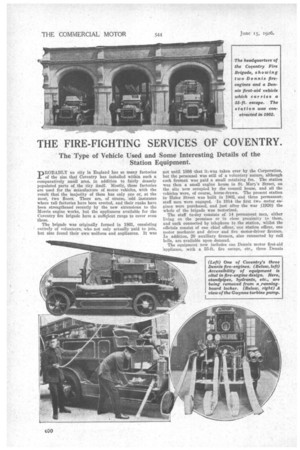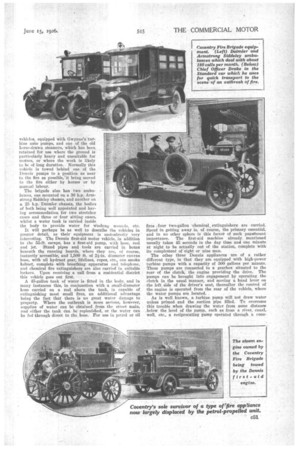THE FIRE-FIGHTING SERVICES OF COVENTRY.
Page 32

Page 33

Page 34

If you've noticed an error in this article please click here to report it so we can fix it.
The Type of Vehicle Used and Some Interesting Details of the Station Equipment.
nROBAIBLY no city in Thigland has so many factories of the size that Coventry has installed within such a comparatively small area, in addition to fairly densely populated parts of the City itself. Mostly, these factories are used for the manufacture of motor vehicles, with the result that the majority of them has only one or, at the most, two floors. There are, of course, 'odd instances where tall factories have been erected, and their ranks have been strengthened recently by the new extensions to the Morris engine works, but the appliances available for the Coventry fire brigade have a suiVent range to cover even these.
The brigade was originally formed in 1861, consisting entirely of volunteers, who not only actually paid to join, but also found their own uniform and appliances. It was
not until 1898 that it, was taken over by the Corporation, but the personnel was still of a voluntary nature, although each fireman was paid a small retaining fee. The station was then a small engine house in St. Man's Street, on the site now occupied by the council house, and all the vehicles were, of course, horse-drawn. The present station in Hales Street was built in 1002, and three permanent: staff men were engaged. In 1914 the first two motor engines were purchased, and just after the war .(1920) the whole of the brigade was motorized.
The staff to-day consists of 14 permanent men, either living on the premises or in close proximity to them, and each connected by telephone to the station, whilst the officials consist of one chief officer, one station officer, one motor mechanic and driver and five motor-driver firemen. In addition, 20 auxiliary firemen, also connected by call bells, are available upon demand.
The equipment now includes one Dennis motor first-aid 'appliance, with a 55-ft. fire escape, etc., three Dennis
vehicles equipped with Gwynne's'turbine auto pumps, and one of the old horse-drawn steamers, which has been, retained for use where the ground is particularly heavy and unsuitable for motors, or where the work is likely
to be of long duration. Normally this vehicle is towed behind one of the Dennis pumps to a position as near to the fire as pussible,'It being moved to the fire either by horses or by manual labour.
The brigade also has two ambulances, one mounted on a 30 h.p. Armstrong Siddeley chassis, and another on a 25 h.p. Daimler chassis, the bodies of both being well appointed and having accommodation, for two stretcher cases and three or four sitting cases, whilst a water tank is carried inside the body to provide water for Washing wounds, etc. It will perhaps be as well to describe the vehicles in greater detail, as their equipment is undoubtedly very interesting. The Dennis first-aid motor vehicle, in addition to the 554t. escape, has a first-aid pump, with hose, reel and jet. Stand pipes and tools are carried in boxes beneath the running hoards, where they ere, of course, instantly 'accessible, and 1,500 ft. of 24-in. diameter canvas hose, with all hydrant gear, lifelines, ropes, etc., one smoke helmet, complete with breathing apparatus and telephone, and chemical fire extinguishers are also carried in suitable lockers. Upon receiving a call from a residential district this vehicle goes out first.
A 45-gallon tank of water is fitted in the body, and in many instances this, in conjunction with a small-diameter hose carried on a reel above the tank, is capable of extinguishing most small fires, an additional advantage being the fact that there is no great water damage to property. Where the outbreak is more serious, however, supplies of water can be obtained. from the street main, and either the tank Can be replenished, or the water can be fed through direct to the hose. For use in petrol or oil fires . four two-gallon 'chemical, extinguishers are carried. Speed in getting away is, of course, the primary essential, and in no other sphere is this factor of such paratnount importance. The first-aid machine already mentioned usually takes 45 seconds in the day time and one minute at night to be actually out of the station, complete with its complement of eight or nine men.
The other three' Dennis appliances are of a rather different type, in that they are equipped with high-power turbine pumps with a capacity of 500 gallons per minute. These pumps are connected to a gearbox situated to the rear of the clutch, the engine providing the drive. The pumps can be brought into engagement by operating the clutch in the usual manner, and moving a hand lever on the left side of the driver's seat, thereafter the control of the engine is operated from the rear of the vehicle, where the water pumps are located.
As is well, known, a turbine pump will not draw water unless primedand the suction pipe filled. To overcome this trouble when drawing the water from some distanoe -below the level of the pump, such as from a river, canal, well, etc., a reciprocating pump operated through a cone type clutch is fitted, and actually withdraws the air from the suction pipe, priming the pump at the same time. The turbine pump will deliver 500 gallons per minute through one 1i-in. jets, two 1-in, diameter jets or four i-in. jets, at a pressurg of 120 lb. per sq. in. One of the illustrations shows how several hoses can be connected with the delivery side of the pump, and further subdivisions can be made by attaching Y-type branches to the ends of these hoses, so that a fire" can be approached from a wide range with numerous jets.
In addition to the -large turbine pump, these three machines also have a first-aid pump, ,tank and reel, with a device for refilling the tank from a hydrant, or (by operating a lever on the near side of the body) to enable water to be taken straight through to the jet. This, like the firstaid vehicle already described, is for use at small fires where water damage would be of serious consequence. The sole surviving steam engine has a capacity of 500 gallons per minute from a vertical two-cylinder pump driven from a direct-acting twin-cylinder steam engine.
On all the petrol-driven vehicles a Kigas easy-starting device is fitted. A hand pump located on the dash draws from a container immediately above it and introduces petrol at the points where the induction manifold is attached to the cylinder blocks, the petrol impinging upon a fan which atomizes the fluid and so prevents fouling or condensation on the plug points. That this device does Its work is proved by tests which we made during our visit to the station. Three of the vehicles were approached when their engines were quite cold, and attempts made to start up against the stop-watch. In each case the engine was running within 12 seconds, one engine being started in as short a time as 10 seconds. These times include priming and twinging the engine to obtain the two or three initial strokes necessary for " sucking in "—surely a verycreditable performance.
In comparison with the factors of speed and reliability, economy of running is of minor importance, but on this score, too, the motorized fire. brigade shows to advantage in Coventry. .Against the stabling hills for horses, whether in use or not, can be placed the fact that the motors do not consume fuel except while actually Working. Furthermore, the modern machine comprises a powerful water pump, escape and a smaller auxiliary pump forming a selfcontained unit thoroughly capable of dealing with the average outbreak, whereas with horses as many as -three or possibly four appliances were necessary in order to have similar equipment available. Added to this the rapidity with which the modern type of pump can be put into operation is also a feature of great importance.




















































